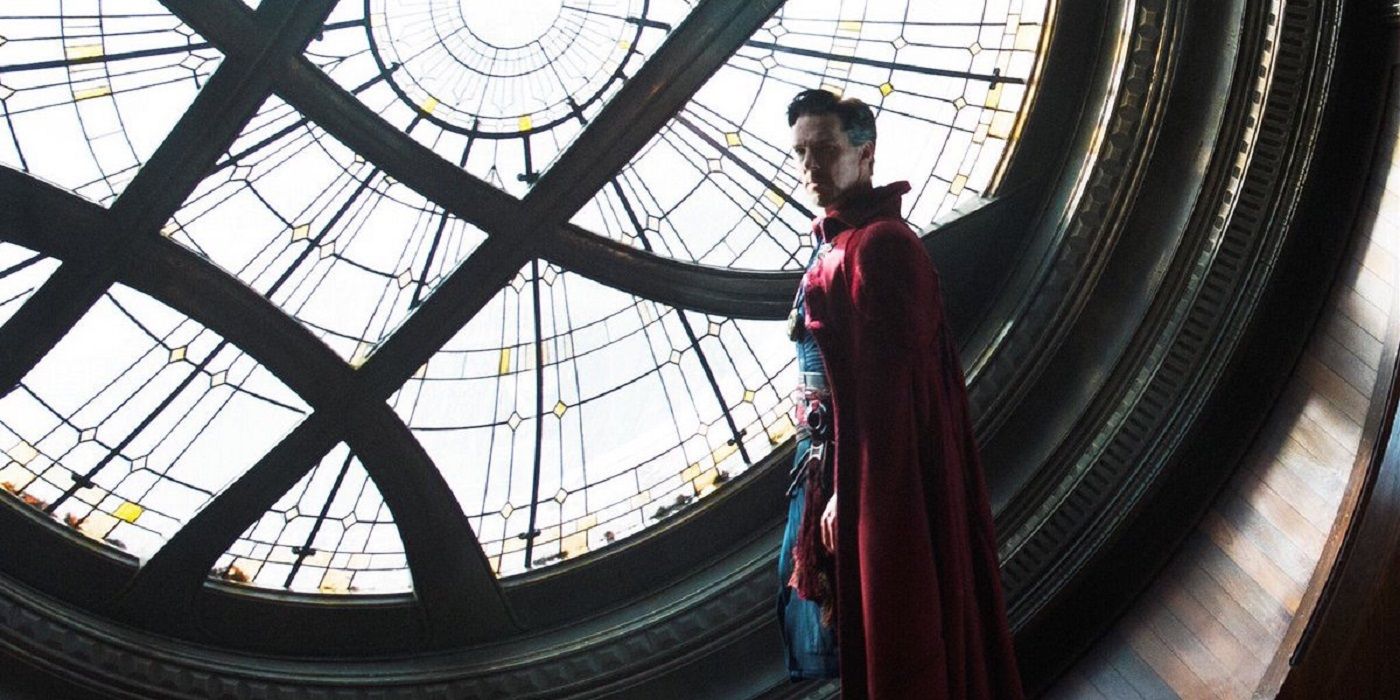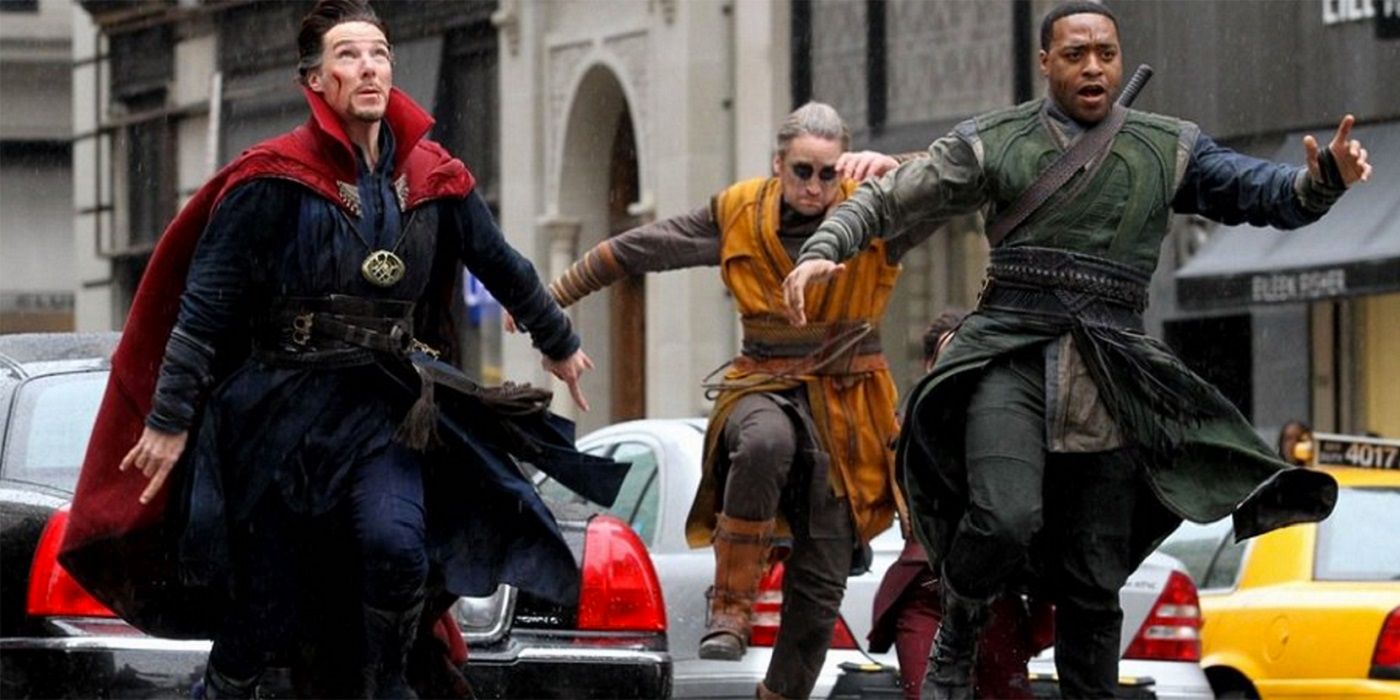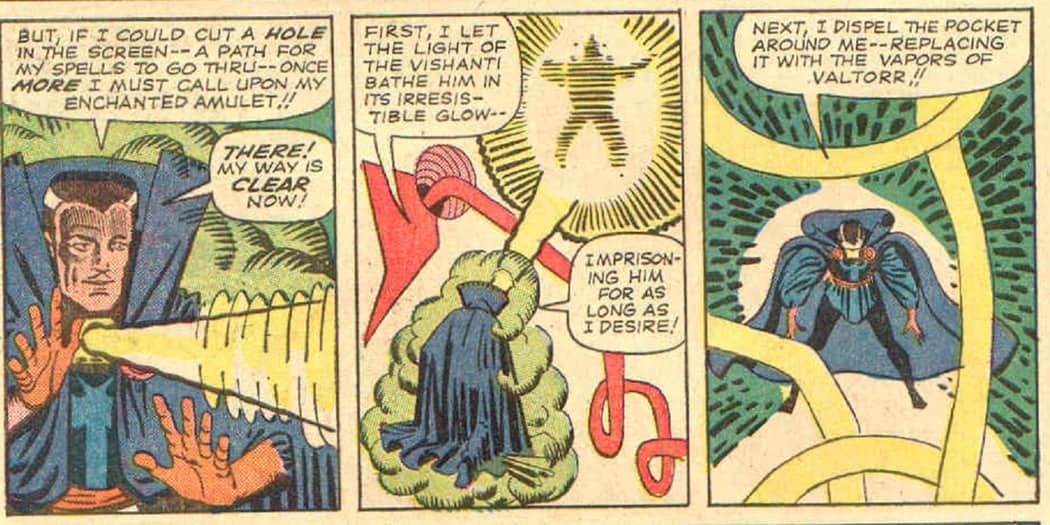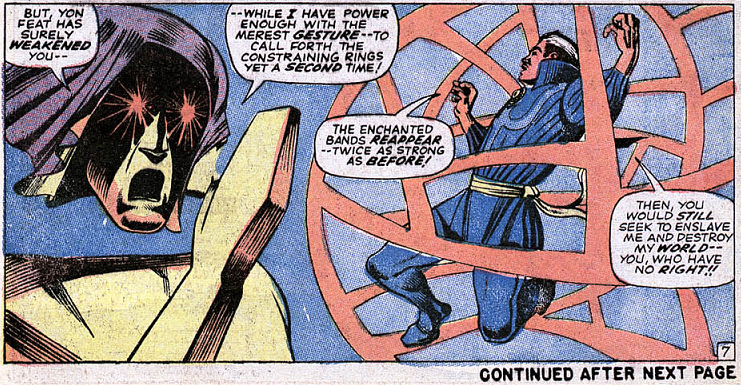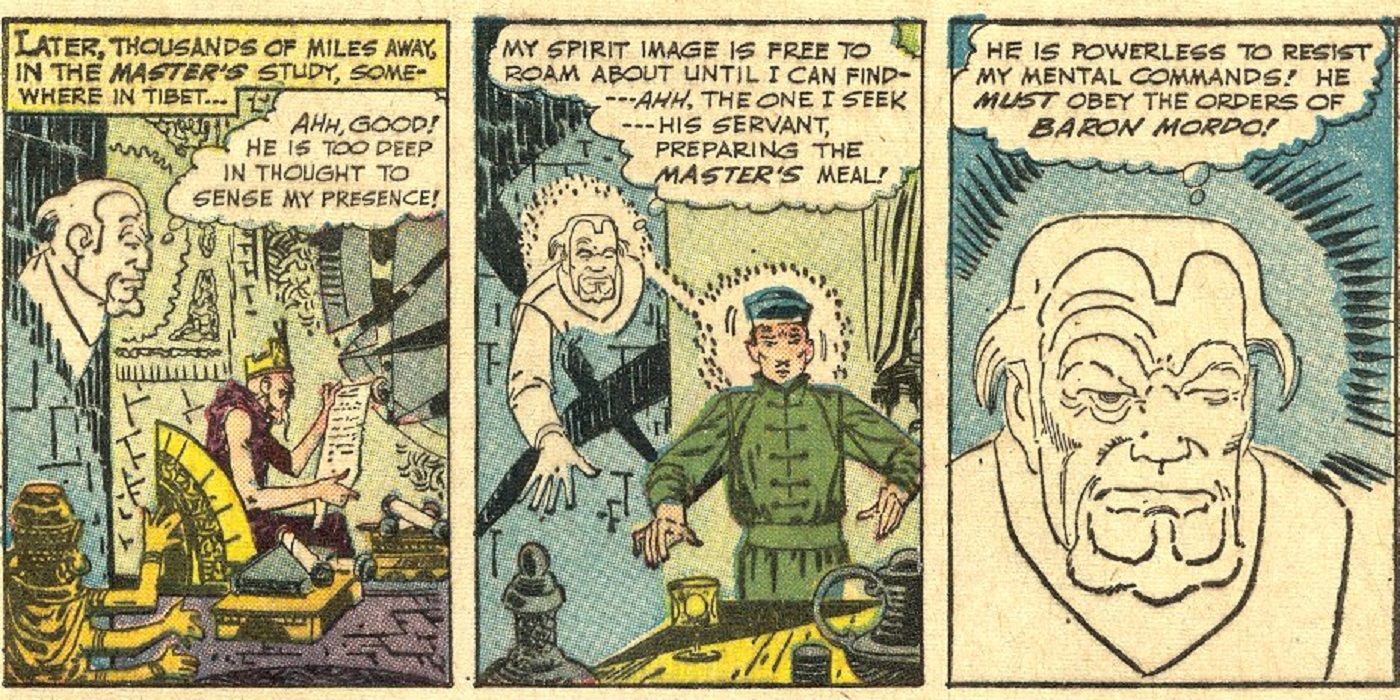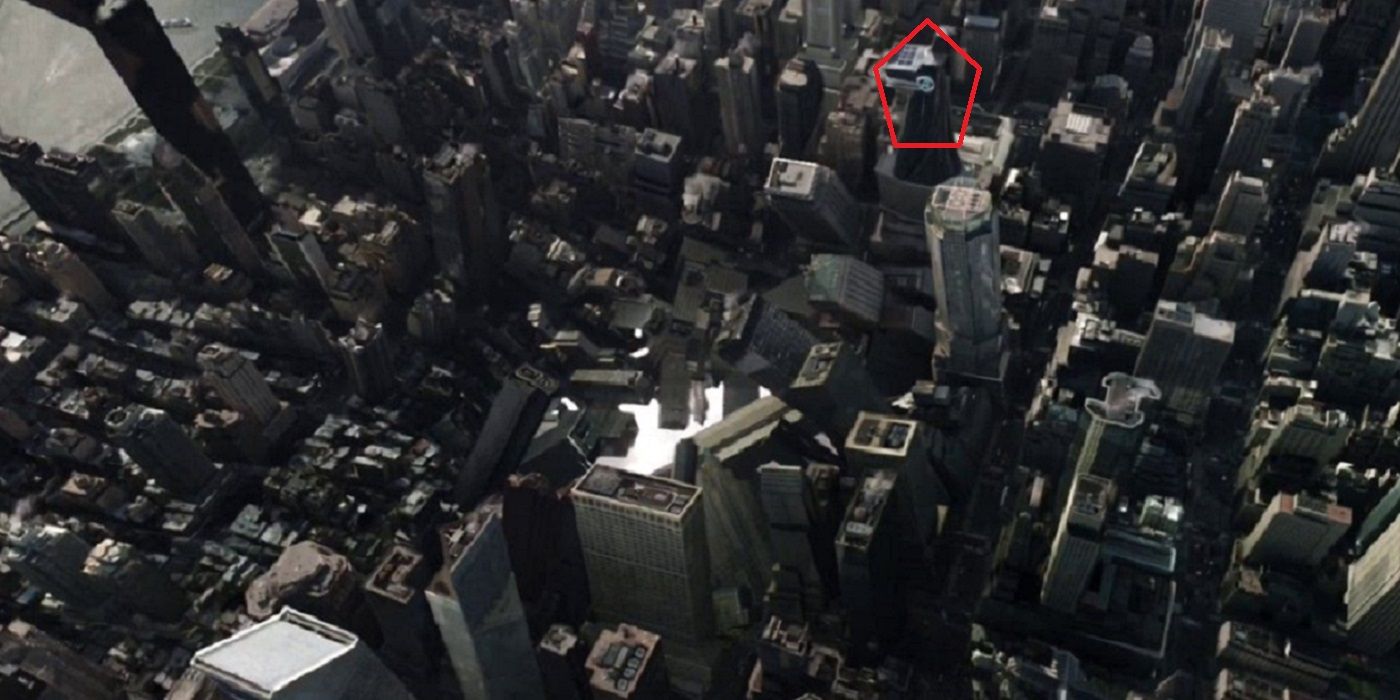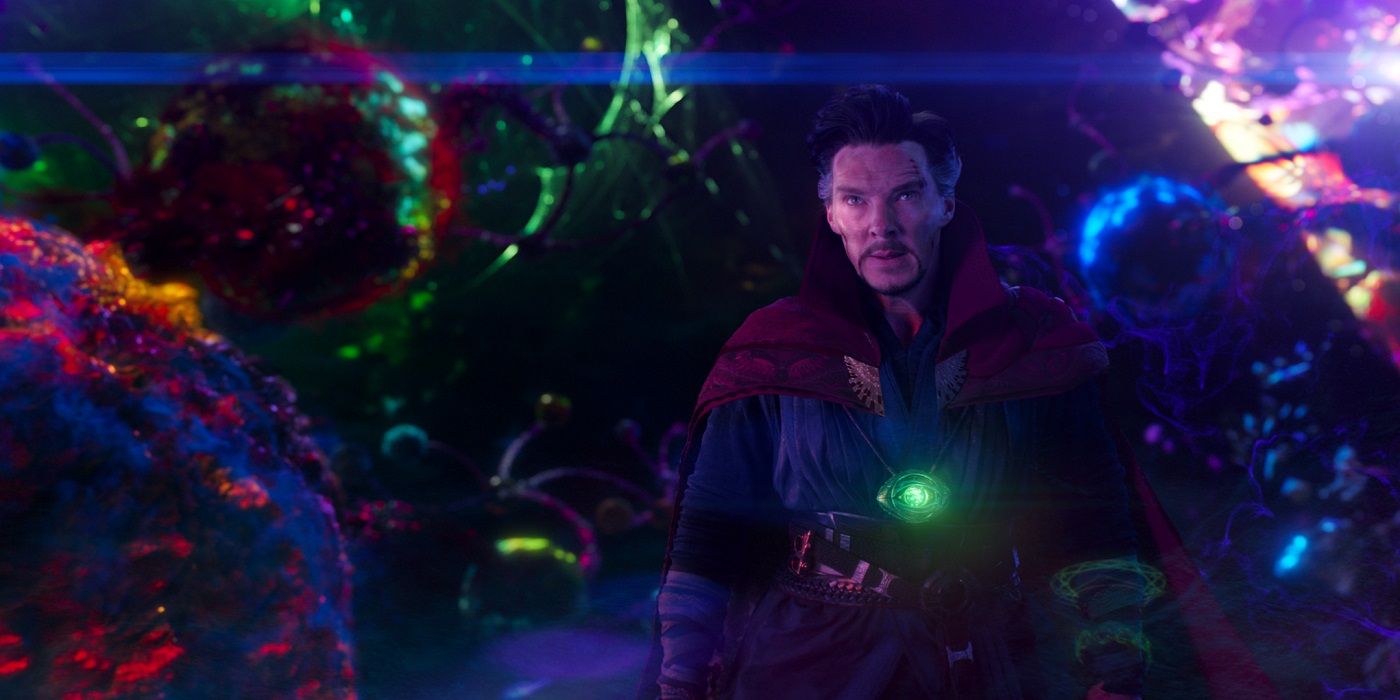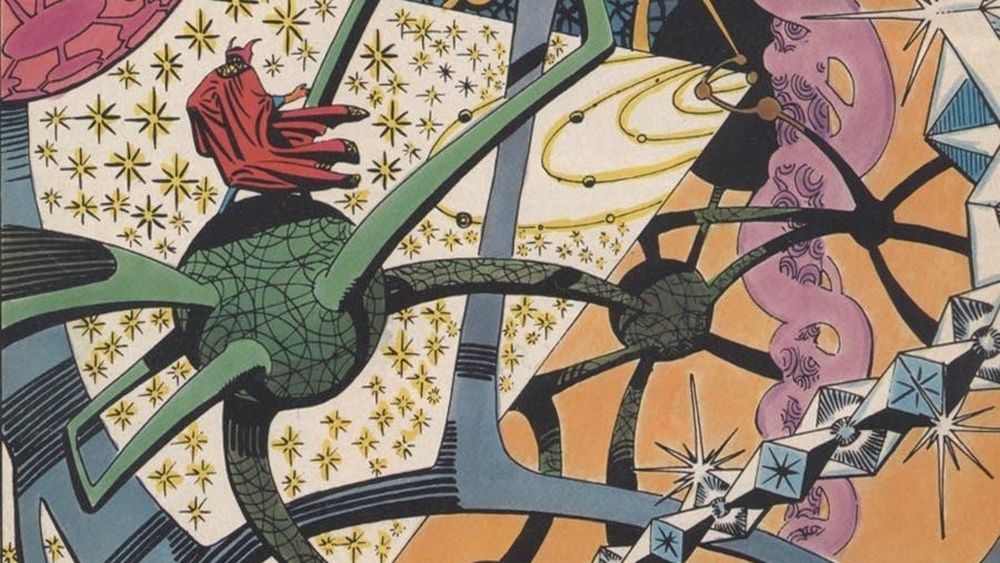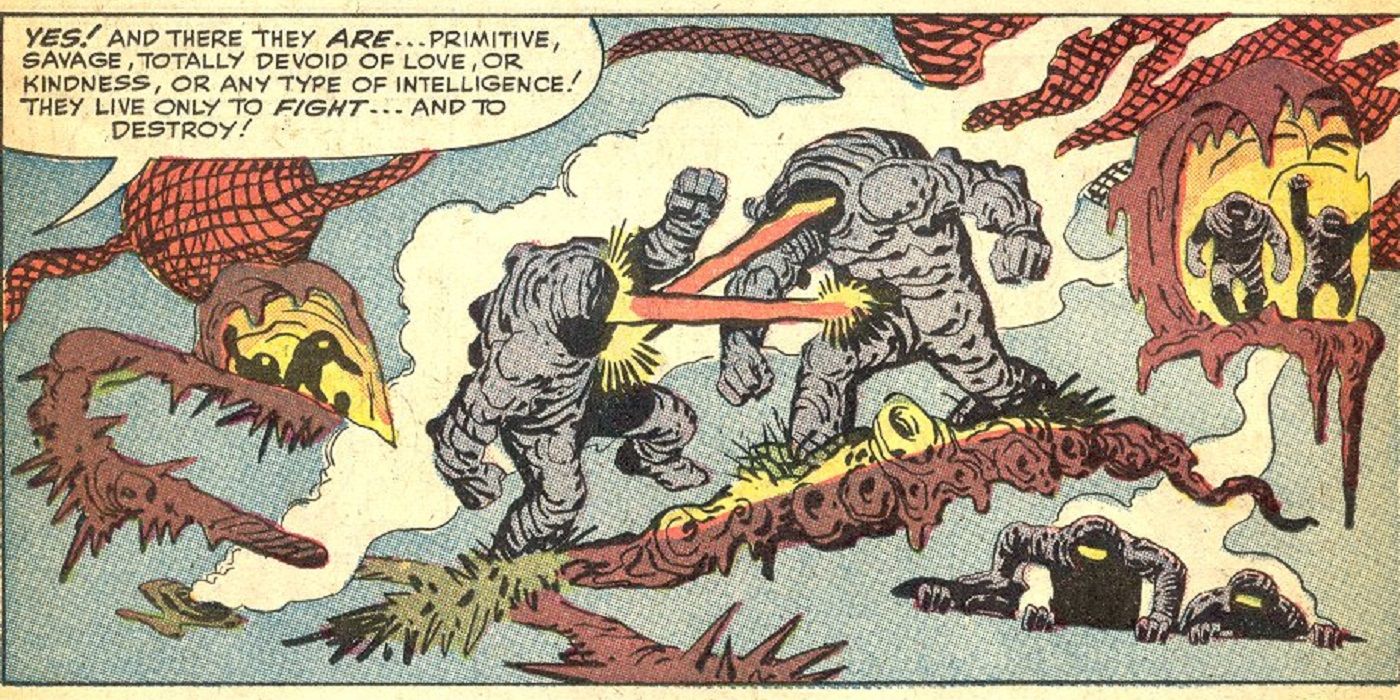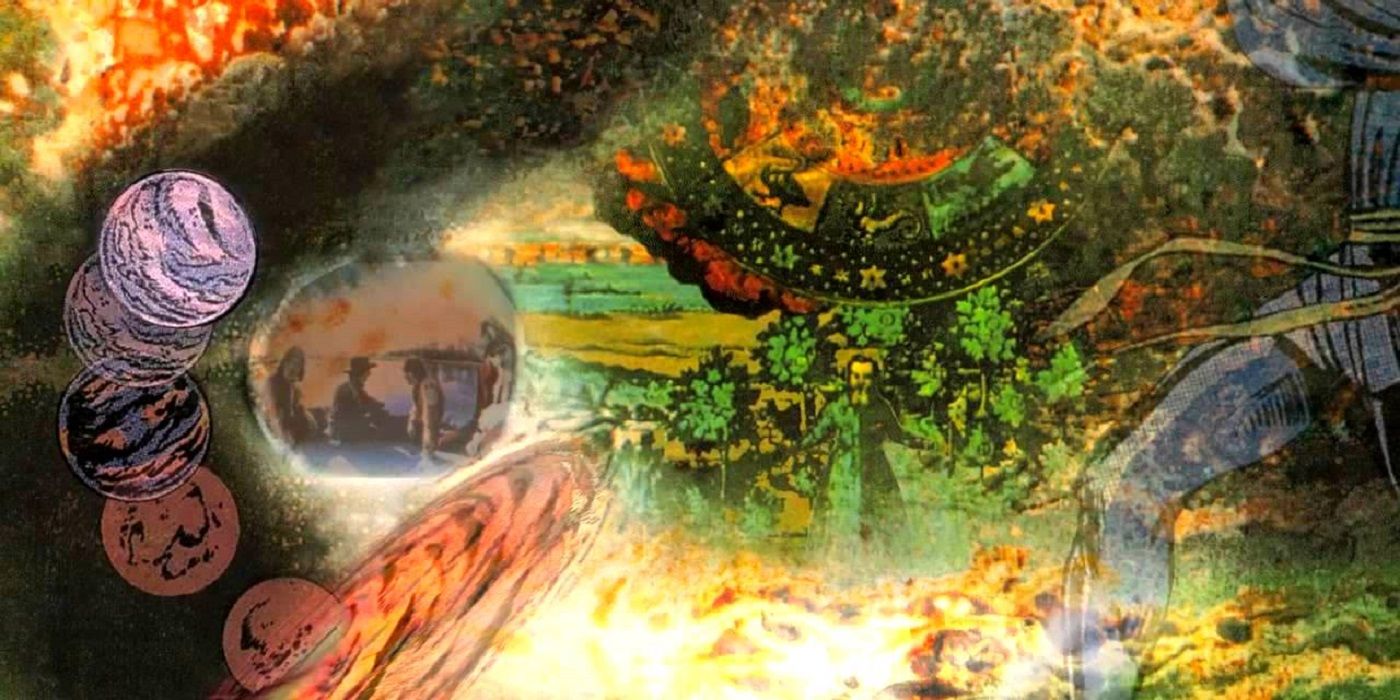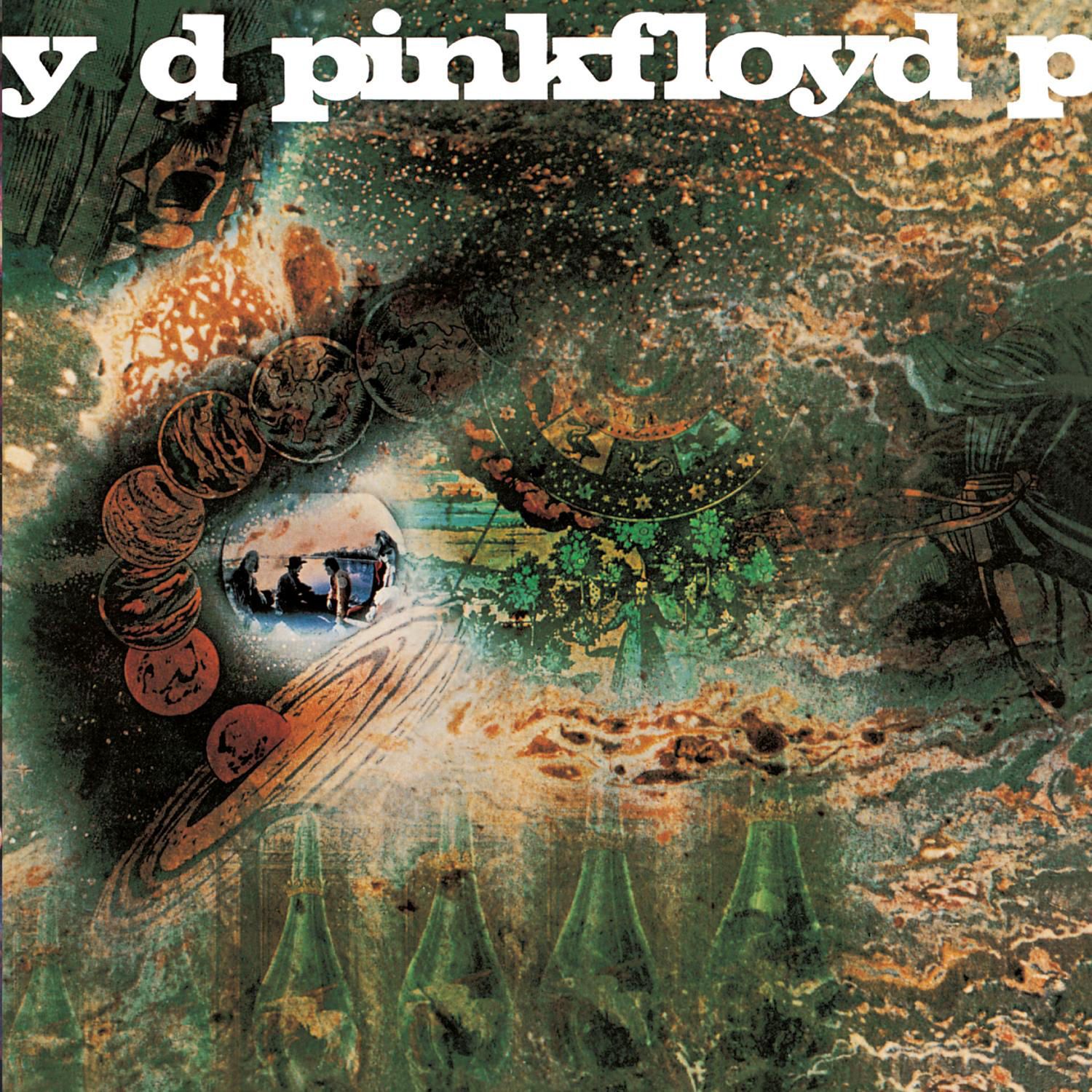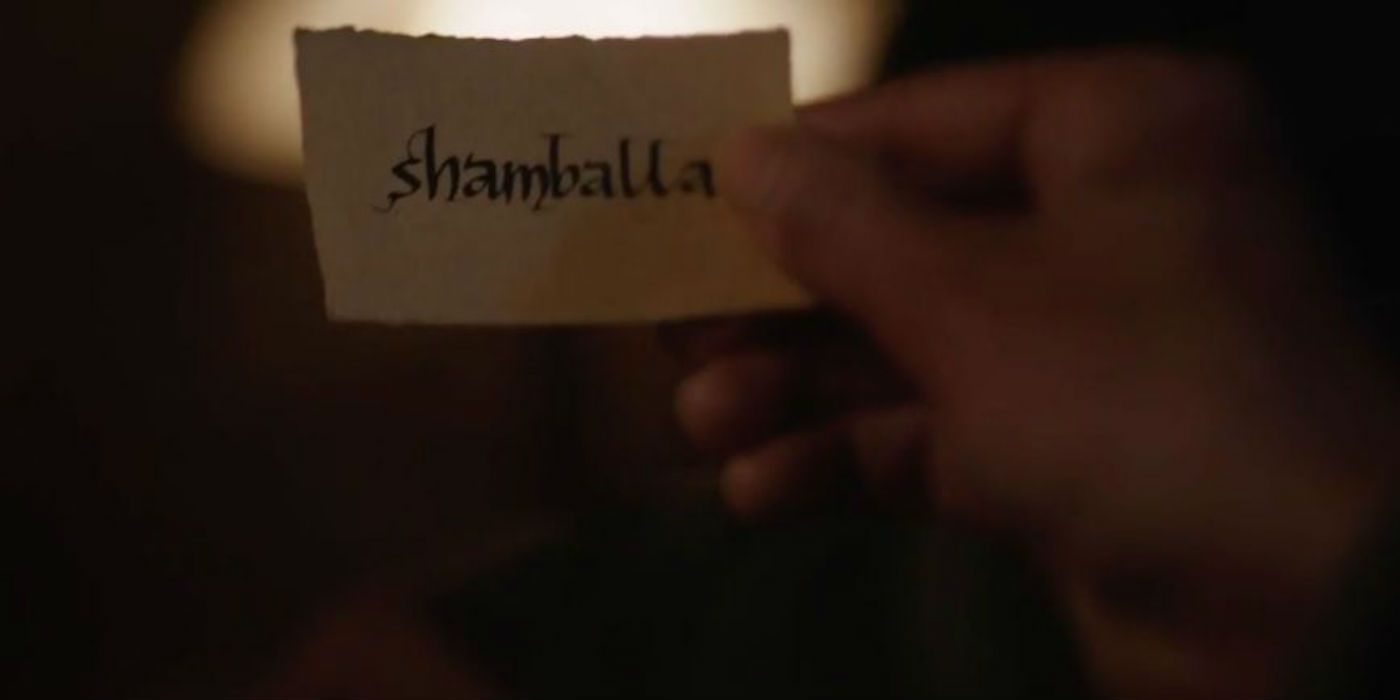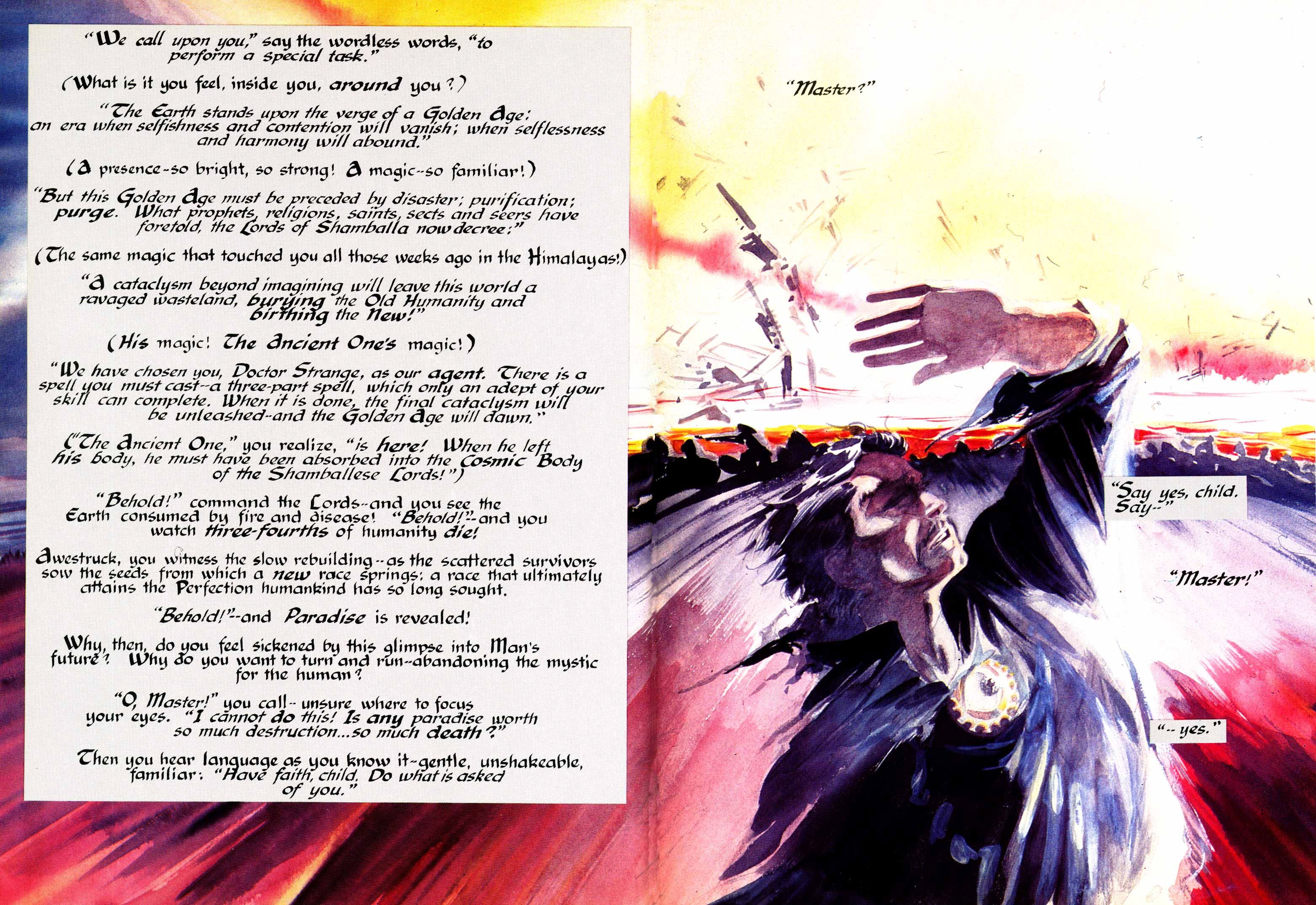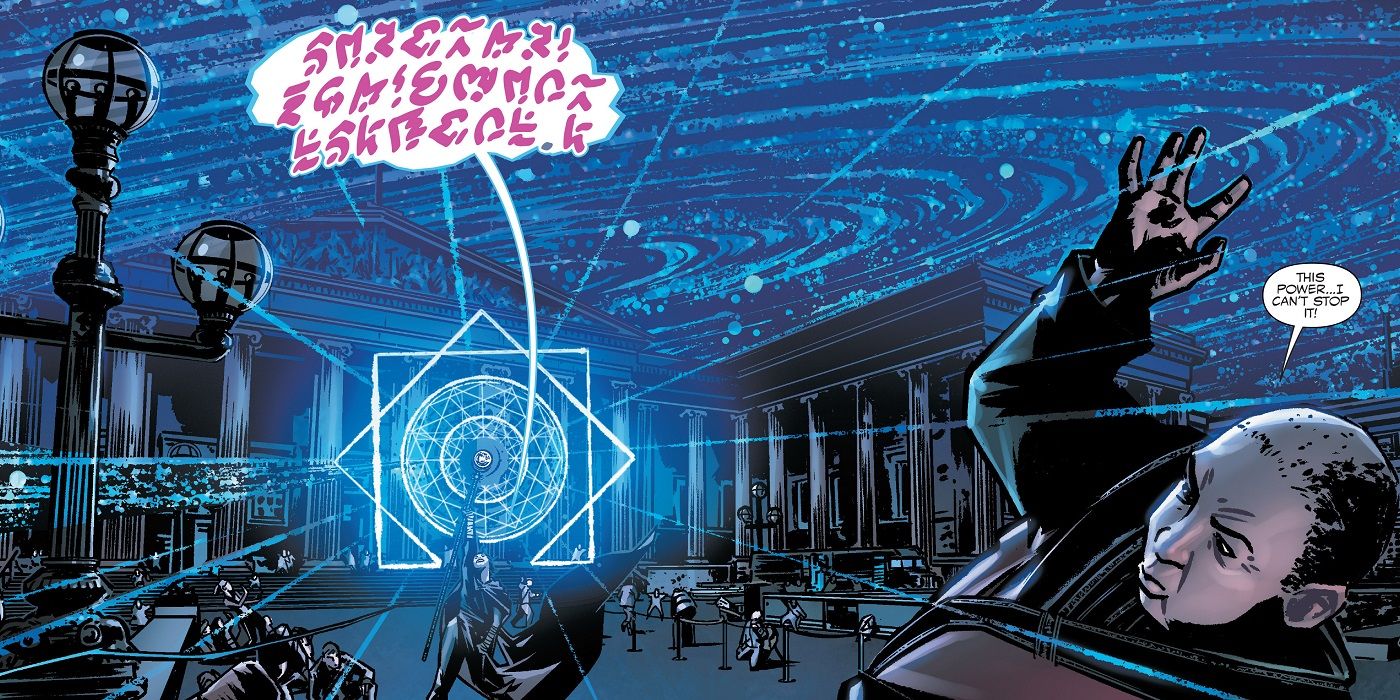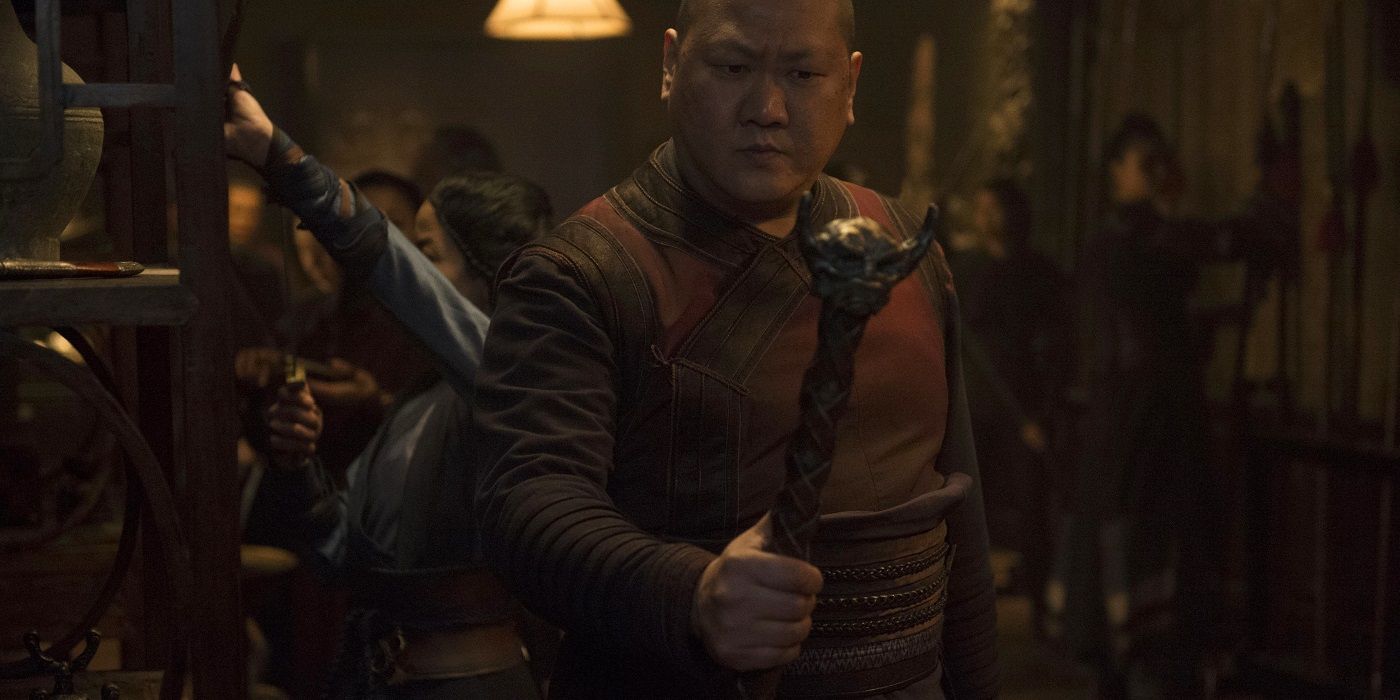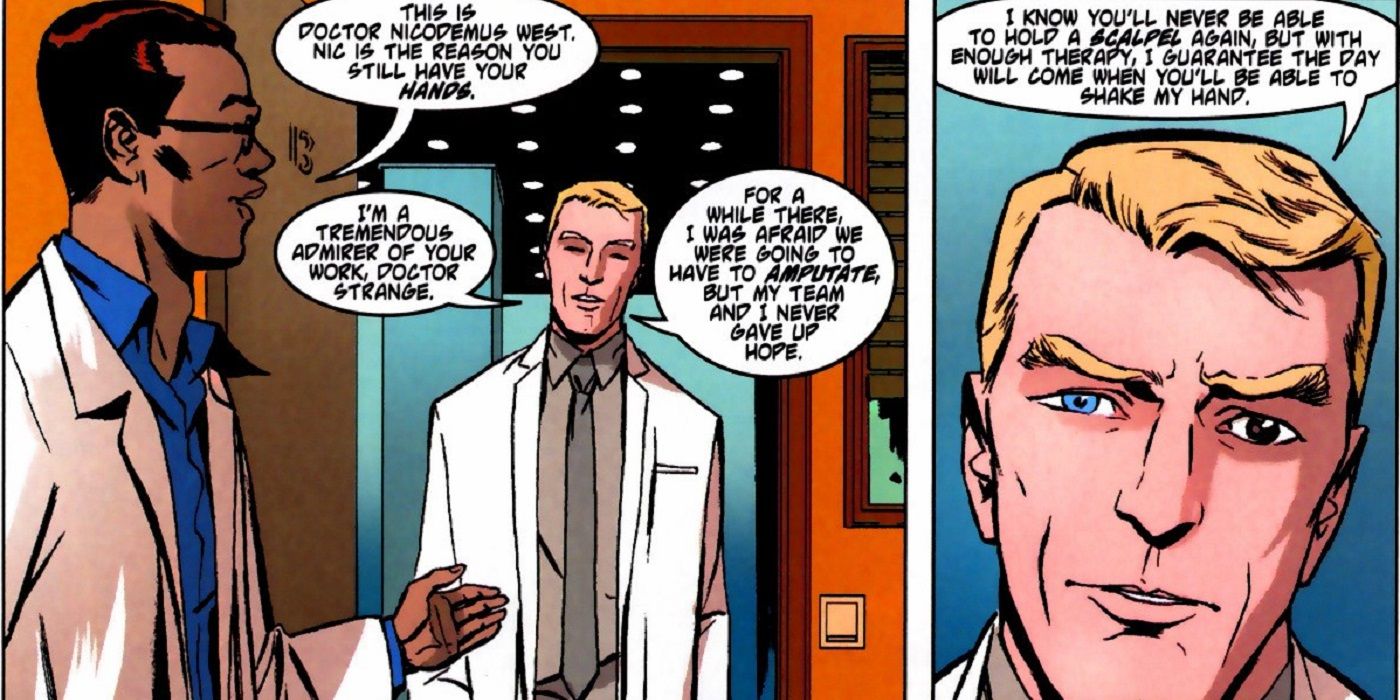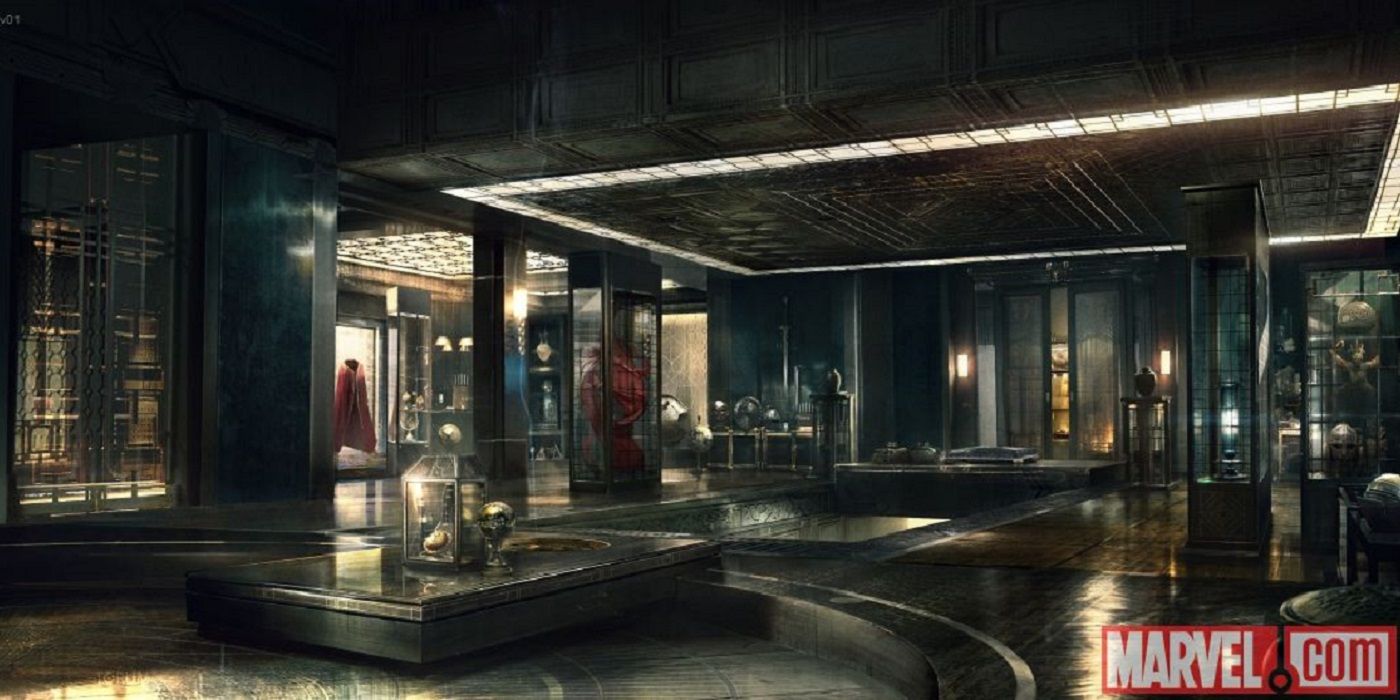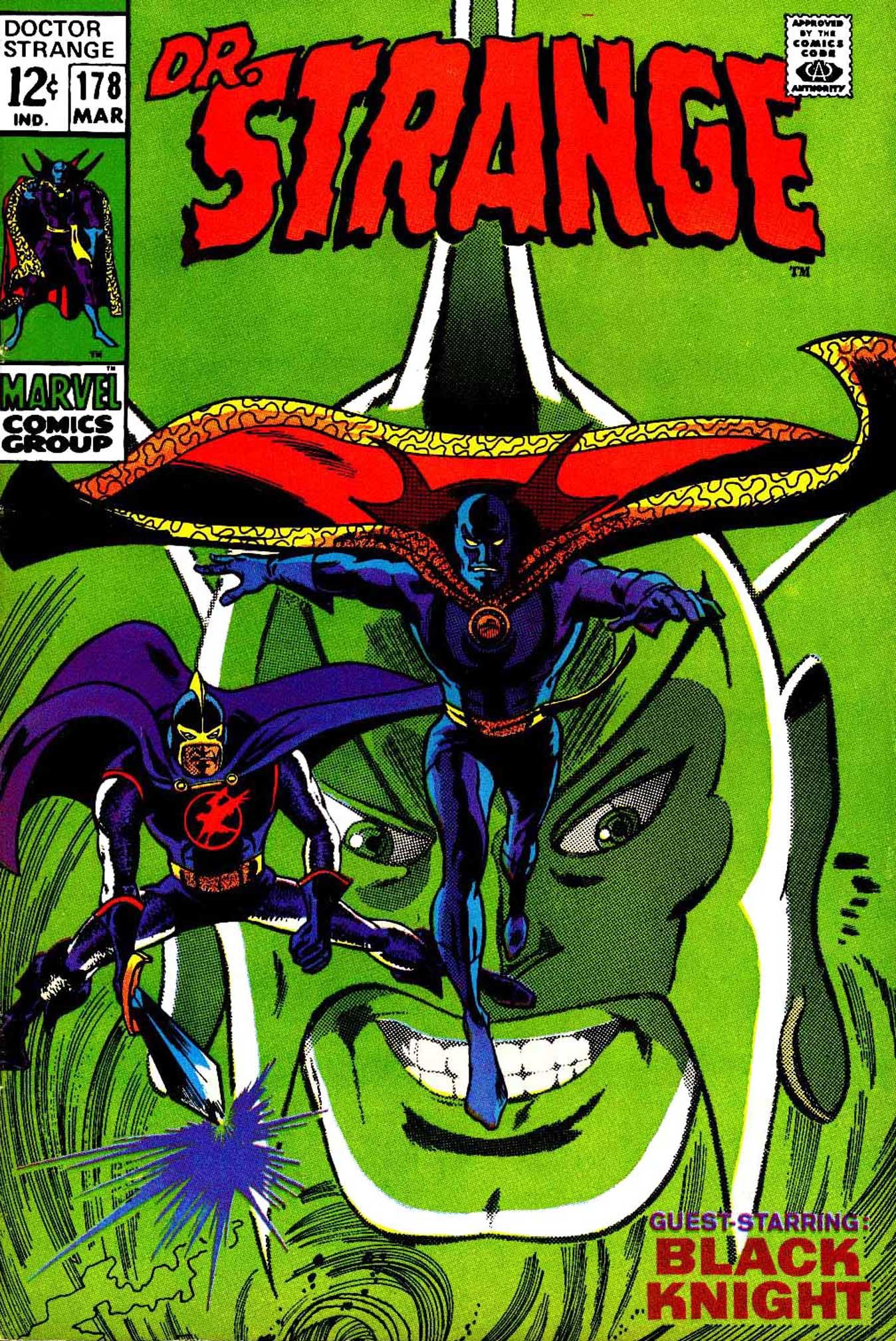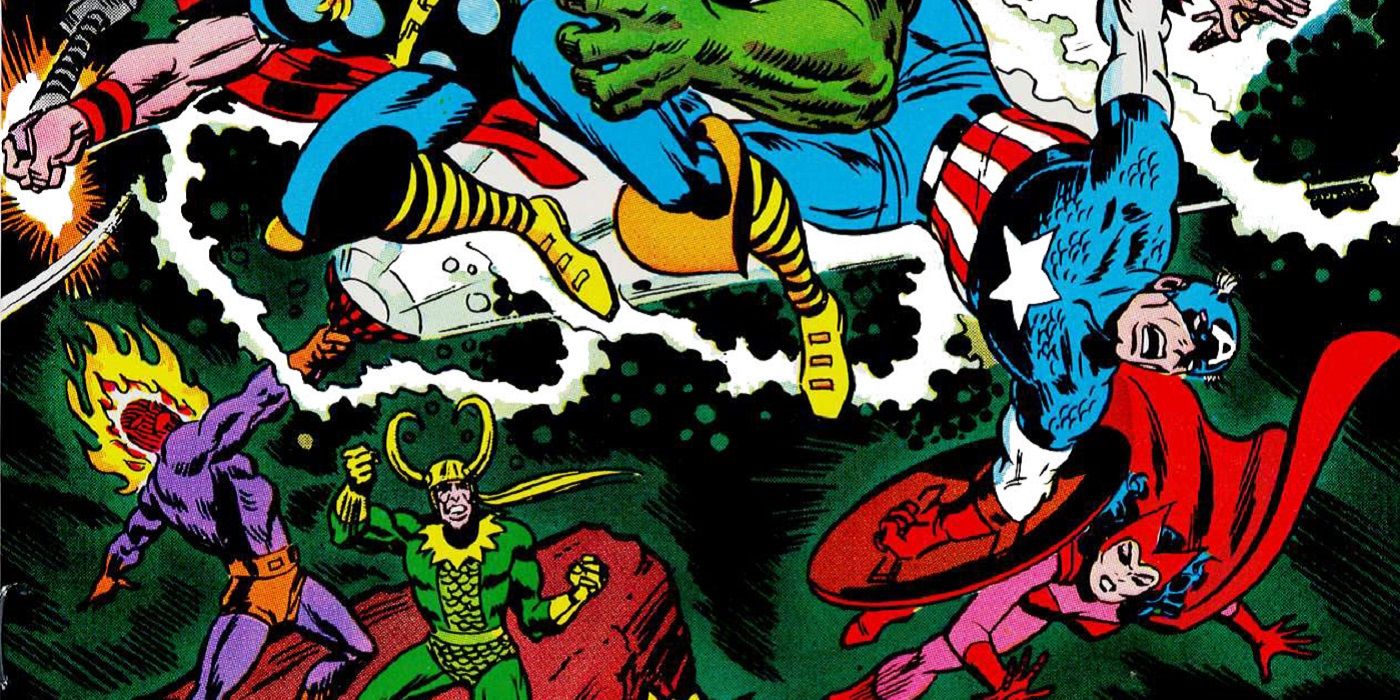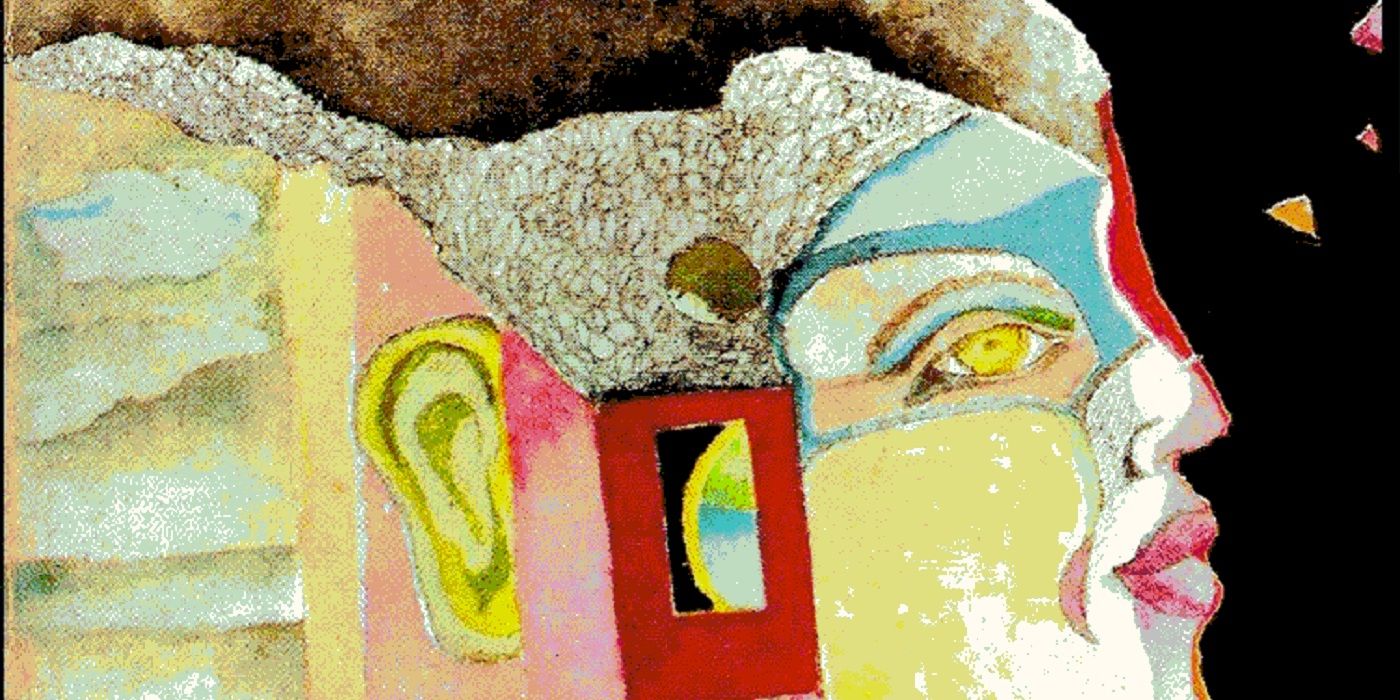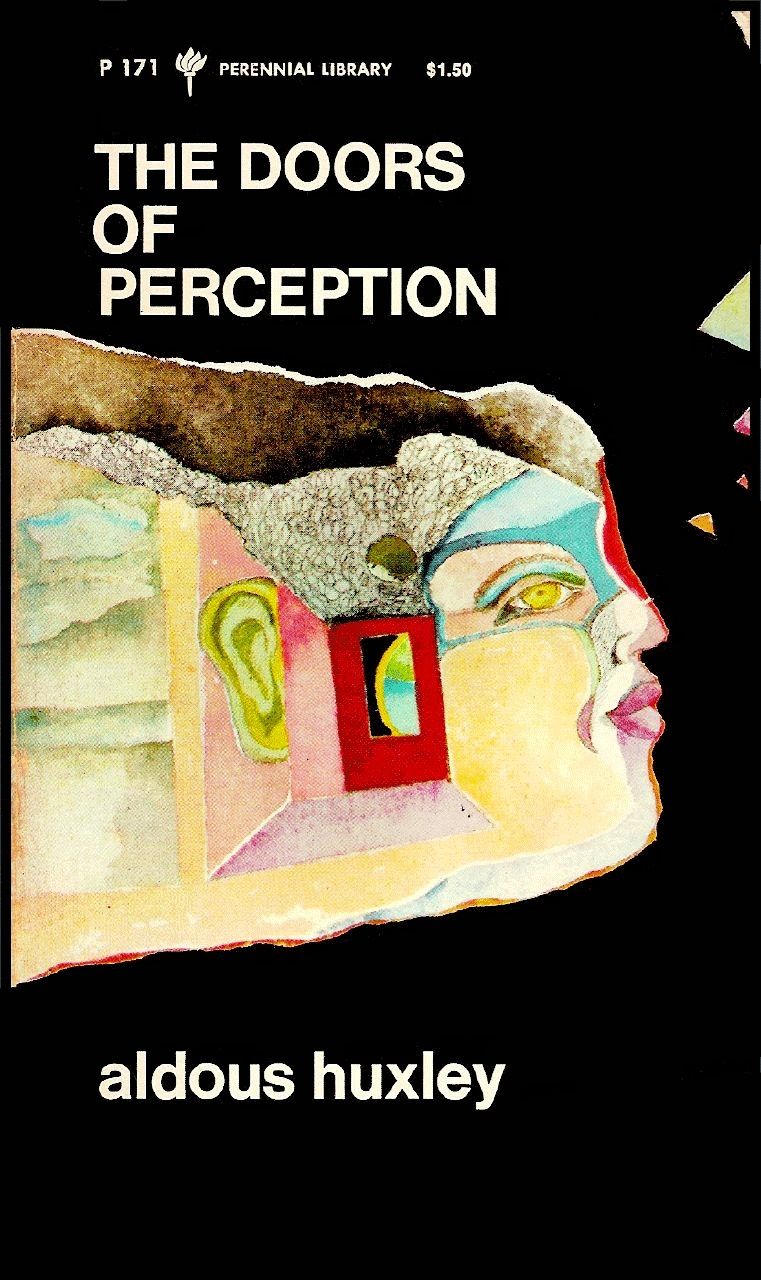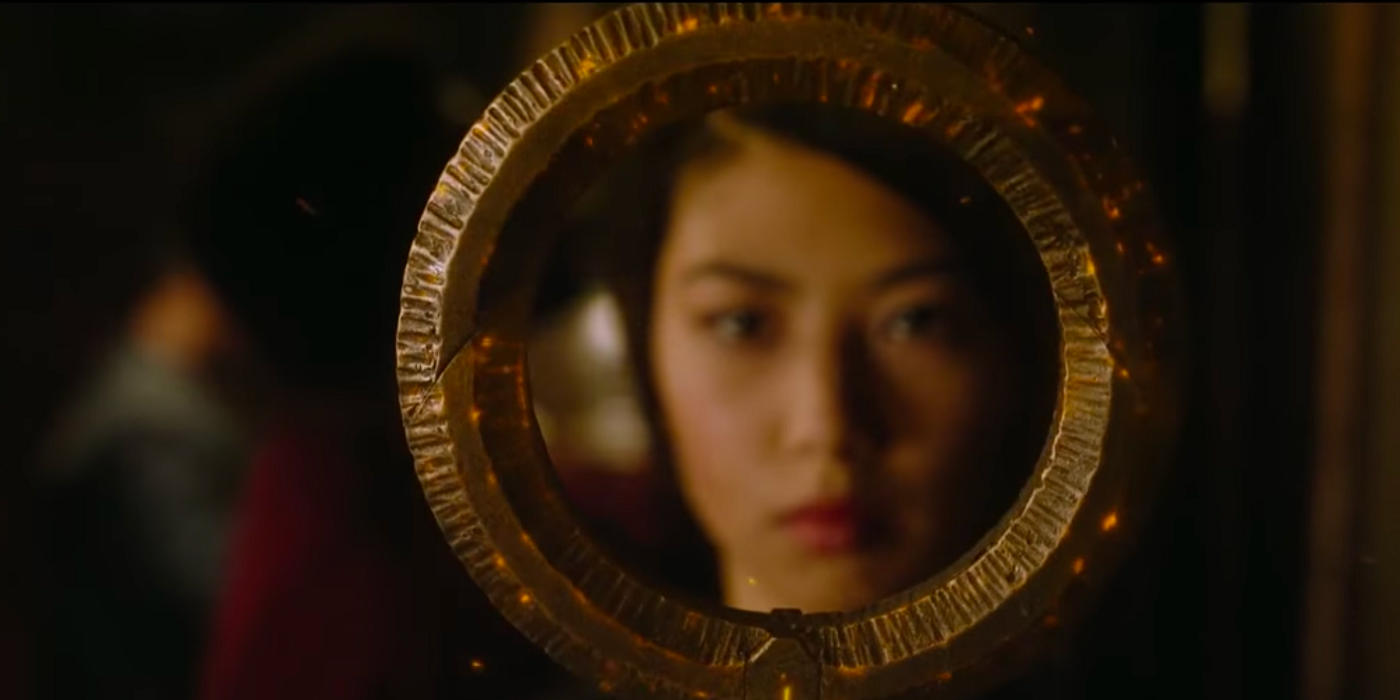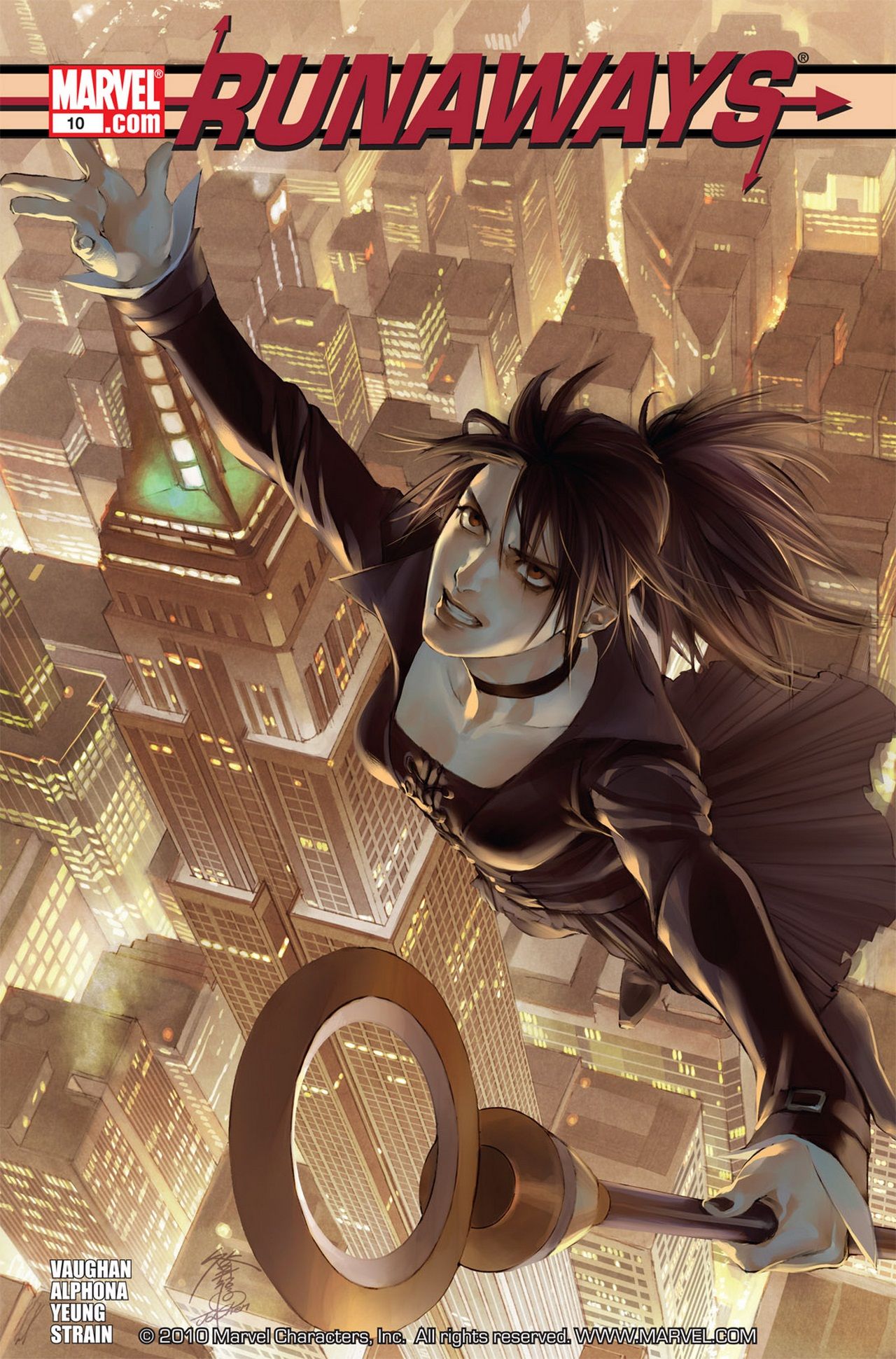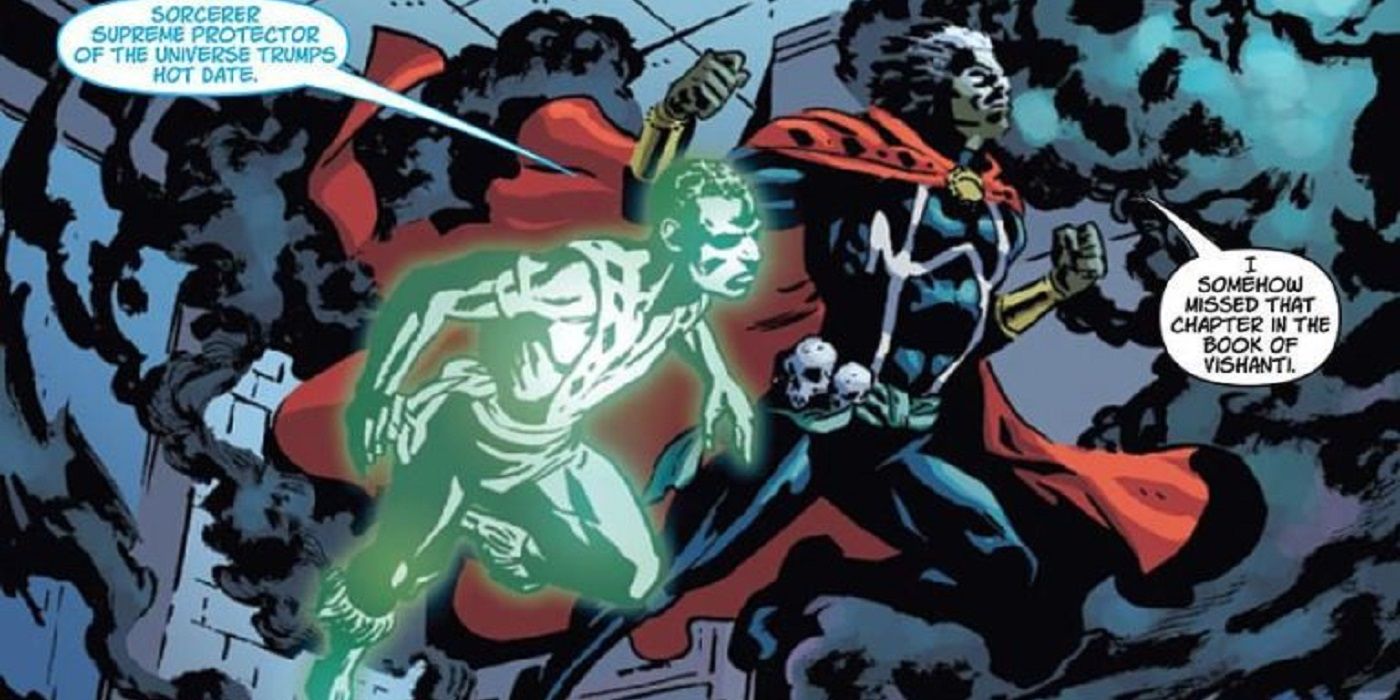WARNING: The following list may contain spoilers for the Doctor Strange movie.
One of the interesting things about Marvel's latest hit film, "Doctor Strange," is that since the character is so relatively unknown outside of comic book fans, practically everything within his new film could be seen as a "hidden" reference to viewers of the film, even something as major as Doctor Strange's famous Eye of Agamotto. However, when it comes to comic book fans, the references have to be a lot more obscure to truly qualify as an "Easter Egg."
RELATED: Doctor Strange: His 15 Greatest Allies
For instance, the Book of Cagliostro is a major part of the film and has been a major Doctor Strange magical artifact, so it seems like a stretch to call its appearance in the film an "Easter Egg." Same with adapted scenes, like the awesome "Doctor Strange talks to Palmer in his astral form while she operates on his physical body" scene in the film that was taken from Brian K. Vaughan and Marcos Martin's "Doctor Strange: The Oath." Adapting whole scenes seems a bit more than just an "Easter Egg."The following 15 Easter Eggs, therefore, are more fleeting references and more obscure pieces of comic book ephemera, ranked by how obscure and clever the references are within the film.
15 Baron Mordo's Outfit
Baron Mordo is decked out in an outfit that contains a number of Easter Eggs mixed into it, although in a unique fashion, in the sense that neither of the items described are actually from the comics themselves, but they do make reference to aspects of the comic books. The first is Mordo's "leaping boots of Valtorr", which allow him to leap great distances. This is a reference to the magical deity Valtorr that Doctor Strange often invokes for spells (#11 on our list explaining Doctor Strange's greatest spell invocations). Strange typically cites either the "Vapors of Valtorr" or the "Vipers of Valtorr."
Mordo is also armed with the Staff of the Living Tribunal, a reference to the powerful cosmic being known as the Living Tribunal, who judges all cosmic disputes in the Marvel Universe and had tangled with Doctor Strange on a few occasions.
14 Hamir
There's a notable scene in the film where Stephen Strange is trying to excuse his poor showing in his spell casting as being a result of the nerve damage within his hands. The Ancient One quickly shuts him up by bringing out one of the other masters, Master Hamir, who is missing a hand. Hamir promptly demonstrates a perfectly cast spell, done with only one hand. Strange is suitably chagrined.
Hamir is an actual character from the comics. His debut came all the way in Doctor Strange's second appearance ever, in "Strange Tales" #111 (that issue also had Baron Mordo's first appearance). Unnamed at the time, Hamir was the Ancient One's main servant. Over time, we have learned more about him (including his name). The most important piece of information about Hamir is that he was ultimately revealed to be the father of Wong, Doctor Strange's right-hand man. In the comics, Hamir has both of his hands.
13 Avengers Tower
In one of the New York City scenes in "Doctor Strange", Avengers Tower can be seen among the other buildings (we've put a red pentagon around it to make it easier to see). That, alone, is a pretty cool Easter Egg. However, its placement in the film is more important than just a cool little thing mixed into the background.
You see, the story of "Doctor Strange" takes place over the course of a few years, and thus it is important to show that Avengers Tower was in place before the final battle in the film, which would likely place the film before "Avengers: Age of Ultron", where the Avengers gave up on Avengers Tower and moved to a facility further upstate in New York. Thus, this Easter Egg might also serve to figure out where "Strange" is set in the continuity of the other movies. This is one of the reasons why the man who was injured from the experimental armor that Doctor Strange is offered to work on on his car phone before Strange crashes his car wouldn't be a reference to War Machine and his "Civil War" injury, as the scene in "Strange" takes place years before "Civil War." This could also explain why Agent Stillwell lists Stephen Strange as a threat to Hydra in "Captain America: Winter Soldier."
12 Ditko's Dark Dimension
As he continued to develop the "Doctor Strange" feature in "Strange Tales", Steve Ditko became more and more inventive with the backdrops of Strange's forays into other dimensions, including most famously the Dark Dimension where Dormammu was the ruler. A number of college students in the 1960s were quite taken with how trippy Ditko depicted the dimensions. It soon became a hallmark of the "Doctor Strange" feature and Ditko got more and more detailed until he gave the feature up entirely when he quit Marvel.
The director of "Doctor Strange", Scott Derrickson, specifically stated that the film flat out adapted Ditko's depiction of the Dark Dimension for the film's depiction of the Dark Dimension.
Derrickson noted, "Ditko’s artwork was very psychedelic, very ‘60s, and that was the counter-culture making its way into the Marvel Universe. I felt very strongly that art was still progressive and had not been imitated. I don’t think visual effects were ready to try and imitate him, but VFX finally caught up with Steve Ditko.”
11 Mindless Ones
At the end of the film, there was an excellent payoff to Kaecilius' obsession with eternal life. Kaecilius believed that the Ancient One was hiding the secret to eternal life from her students and that the ultimate answer was to bring Earth to Dormammu's Dark Dimension so that everyone on Earth could live eternally in said dimension. Kaecilius was basically correct that there is eternal life in the Dark Dimension, but it is not eternal life that you would want to live (the whole "Dark Dimension" thing probably should have tipped him off).
So at the end of the film, after Doctor Strange saved the day after striking a bargain with Dormammu, Kaecilius and his disciples got sucked into the Dark Dimension to get their eternal life, but in doing so, they were transformed into unthinking, unfeeling beings. Cleverly enough, then, the depiction of Kaecilius and his disciples transformed was that of the Mindless Ones, long time denizens of the the Dark Dimension. What a clever way of mixing in comic book history with a key plot point!
10 Pink Floyd
As "Doctor Strange" found psychedelia in the mid-1960s, so, too, did the band Pink Floyd find it later on in the decade. Pink Floyd was very early on an admirer of Steve Ditko's "Doctor Strange" (with the good Doctor even getting mentioned by name in the song "Cymbaline", written by Roger Waters). So designer Storm Thorgerson decided to show off their interest in Strange by including him on the cover of their second album, 1968's "A Saucerful of Secrets".
The late Thorgerson explained its inclusion in 2010:
…The cover is an attempt to represent things that the band was interested in, collectively and individually, presented in a manner that was commensurate with the music. Swirly, blurred edges into red astrology/Dr. Strange images merging into images, a million miles away from certain pharmaceutical experiences. Beginning with Saucerful, they were beginning to experiment with more extended pieces and the music would cascade and change from thing into thing.
Therefore, Scott Derrickson had to include a Pink Floyd song in the film, and he went with "Interstellar Overdrive" off of their 1967 debut album, "The Piper at the Gates of Dawn." The song is playing during Stephen Strange's ill-fated car drive early in the film.
9 Shamballa
The scene that probably gets the biggest laughs in the film is a bit right after Stephen Strange has been accepted as a student of the Ancient One. One of her other students, Baron Mordo, shows Strange to his quarters where he can get washed up. He then gives him a piece of paper with the word "Shamballa" written on it. Strange ask if this is his mantra or something like that. Mordo explains that no, it's their WiFi password. Shamballa, of course, is a term that has been around much longer than there have been "Doctor Strange" comics, as references to the ancient city of Shamballa (often also spelled Shambhala) are common in Tibetan Buddhist and Hindu traditions.
However, it is also the name of an acclaimed "Doctor Strange" graphic novel by J.M. DeMatteis and Dan Green, where Doctor Strange tries to find the spirit of the Ancient One in the realm of Shamballa and gets enlisted in a dangerous mission instead.
8 Dark Scepter
Easily the most obscure reference in the entire film, one of the scenes in "Doctor Strange" briefly shows a trophy case in the London Sanctum Sanctorum with a staff of some sort in it. This is the Dark Scepter, and its only appearance to date was in "Prelude to Doctor Strange" #1 by writer Will Corona Pilgrim and artists Jorge Fornes and Jesus Aburtov.
The story is about a young witch who gets a hold of the Scepter and suddenly finds herself with more power than she can possibly handle. After Wong fails on his own to get the Scepter, the Ancient One enlists a group of her top masters to help Wong retrieve the powerful relic. The comic mostly shows what Kaecilius was like before he broke off from the Ancient One, and we can see how Kaecilius has always been on the edge, even when he was still a good guy. In the end, after learning a lesson in trusting one's friends, the masters succeed in retrieving the Dark Scepter and they place it into a case in a Santum Sanctorum (although they put it into the New York City one).
7 Wand of Watoomb
Most of the coolest Easter Eggs in "Doctor Strange" are examples of the prop department going into comic book history to pluck out some of the coolest relics from past comics and include them in the film. Most of these relics are used strictly in a visual sense, as for instance, when the Wand of Watoomb is wielded by Wong in the film, it doesn't seem like it is all that useful, as Wong was slaughtered by Kaecilius and his disciples before Doctor Strange saved his life by altering time. Thus, it is different from the Wand in the comics.
In the comics, the Wand of Watoomb is so powerful that Doctor Strange split it into two parts so that it couldn't be used together. However, the villainous Xandu managed to use Spider-Man to get the second part (after Xandu found the first) and thus, the Wand of Watoomb was together again. Xandu could alter reality itself with the wand! Luckily, he was defeated by Spider-Man and Doctor Strange, and Strange destroyed the wand (it kept getting recreated and Xandu kept coming back for it). Recently, it was revealed that there are multiple wands of Watoomb in the Marvel Universe.
6 Nic West
A minor supporting character in the film is Dr. Nick West, the doctor who had to try to fix Stephen Strange's hands after they were badly damaged in a car accident. Strange treated him poorly when they were co-workers, but the more enlightened Strange had faith in West when it came time to perform surgery on the Ancient One later in the film (she died, but her injuries were irreparable, so it wasn't West's fault).
West is based on a character introduced in "Doctor Strange: The Oath" by Brian K. Vaughan and Marcos Martin (with Alvaro Lopez on inks) called Dr. Nicodemus West. His failure to fix Strange's nerve damage haunted him, so he ended up following Strange to Kamar-Taj, arriving soon after Strange had returned to the United States after completing his own training. West trained under the Ancient One and learned how to do mystic healing. He abandoned his studies and went home. However, he tried to use his healing magic on a patient and the spell went wrong, killing the patient.
West gave up medicine and became the CEO of a pharmaceutical company that agreed to protect him from ever being found culpable for the death of his patient. He and Strange clashed over a powerful magical elixir that Strange wanted to save Wong's life and that West had been hiding because it would hurt the bottom line of his drug company.
5 Black Knight's Helmet
While the Dark Scepter is likely the most obscure reference in "Doctor Strange", the presence of Black Knight's helmet at the Sanctum Sanctorum is probably the hardest to see during the film, as it is only seen for the briefest of moments on top of not being a big helmet. It's on the far-right-hand side of the above image.
The Black Knight is Dane Whitman, whose ancestor was a knight in the time of King Arthur. In modern times, Whitman's uncle had become a supervillain under that name. When his uncle died, Whitman decided to take over as Black Knight, only being a superhero. He wields the cursed Ebony Blade, which thirsts for the blood of the vanquished, but if you give in to that thirst, the sword just takes control of your mind and makes you crave more and more conquest. Whitman has long fought the effects of the curse. The Black Knight and Doctor Strange have long been acquaintances and have gone on a number of adventures together.
4 Evil Eye
Another humorous scene in "Doctor Strange" is when Doctor Strange is surrounded by Kaecilius and his disciples in the New York Sanctum Sanctorum. Strange quickly grabs whatever relics he can find and pulls out one that scares Kaecilius, until Kaecilius calls Strange's bluff and figures out that Strange doesn't know how to use the relic. Strange disagrees and then just uses it to hit Kaecilius and then run. That relic was the Evil Eye.
The Evil Eye was a powerful weapon wielded by the Crusader Prestor John against the Fantastic Four. At one point, it exploded into six pieces. Those six pieces became the basis for the "Avengers/Defenders War", as Loki and Dormammu manipulated the Avengers and Defenders into fighting over who could collect all six pieces to create the Evil Eye. Once finished, Dormammu and Loki turned the Evil Eye on the heroes. Of course, Dormammu then betrayed Loki (since he knew Loki was going to betray him soon enough) and took on all the heroes himself. Ultimately, Loki distracted him long enough for the Avengers to take the Evil Eye from Dormammu and defeat him.
3 Doors of Perception
"The Doors of Perception" was a 1954 essay by Aldous Huxley that was then collected in the United States with another essay ("Heaven and Hell") as the book, "The Doors of Perception"
The essay details the experiences that Huxley had while under the effects of the psychedelic drug Mescaline. The book became a major influence upon proponents of psychedelic drugs, like Dr. Timothy Leary (who became friends with Huxley). The book was a major influence upon psychedelic culture period (Jim Morrison named The Doors after it). That is why director Scott Derrickson made sure to include a reference to the book in "Doctor Strange," since Steve Ditko's drawings were often considered to be another major influence of fans of psychedelia (plus "Doctor Strange," in general, as actually the most famous "Black Light" Doctor Strange poster uses the art of artist Dan Adkins, not Ditko).
The book appears during Stan Lee's cameo, as Lee's character is reading a modern printing of the book on a bus.
2 Staff of One
The aforementioned "Prelude to Doctor Strange" #1 by writer Will Corona Pilgrim and artists Jorge Fornes and Jesus Aburtov also gave more information about another one of Ancient One's masters, Tina Minoru. Tina appeared in the "Doctor Strange" film, but she was not named. However, in both the comic book and the film, her magical relic was the Staff of One.
The Staff of One is familiar to comic book fans, as it is the main weapon of Nico Minoru, Sister Grimm from the classic Brian K. Vaughan and Adrian Alphona comic book series, "Runaways." "Runaways" is about the children of a group of super-criminals who discover that their parents are evil and, well, run away. They become their own sort of superhero team. Nico uses the Staff of One to do spells (she can only do each spell once, so she has to come up with clever ways of doing new spells).
"Runaways" is currently in development as a TV series, so it will be interesting if this connection to "Doctor Strange" is acknowledged. If Tina turns evil, it would sort of speak poorly at how Ancient One chose her Masters, as half of them would have become evil.
1 Daniel Drumm
The best Easter Egg in "Doctor Strange" involves a minor character from the comic books, but a minor character with an important connection to another, more major character, a connection that "Doctor Strange" set up perfectly. In the film, Kaecilius and his disciples break into the New York City Sanctum Sanctorum and kill the Master there, who is only named Daniel at the time. Later, when Ancient One compliments Doctor Strange on how well he did against Kaecilius and his disciples, she tells him that he can take over from Master Drumm as the master of the New York City Sanctum. Thus, the dead master is Daniel Drumm.
This is important because Daniel Drumm is the brother of Jericho Drumm, the powerful practitioner of voodoo known as Brother Voodoo. Jericho Drumm at one point even became Stephen Strange's temporary successor as the Sorcerer Supreme. The main supporting character for Brother Voodoo is Daniel Drumm, who is a ghost that follows his brother around and gives him advice, sort of like Al from "Quantum Leap". Therefore, by introducing Daniel Drumm and killing him, Marvel is very subtly setting up Brother Voodoo for a future cinematic appearance. Very, very clever stuff.
Did we miss any Easter Eggs that you liked? Let us know in the comments!

